Top News
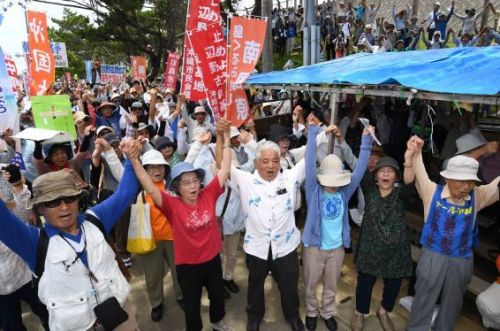
July 8, 2018 Ryukyu Shimpo
On July 7, the All-Okinawa Coalition Against Construction of the New Base in Henoko held a citizens’ rally calling for protection of the dugong and coral.
As for the Henoko base that is being constructed as a replacement facility for Futenma Air Station, the protestors called for soil deposits to not be permitted and for Henoko base construction to be abandoned.
The Okinawa Defense Bureau has announced that soil deposits into the ocean will begin on August 17.
Participants protested with statements like, “Stop construction of a base that ignores popular will.” According to the organizers, 2000 people gathered for the rally.
Governor Takeshi Onaga said, “I certainly cannot approve of [the Japanese government’s] lack of consideration for the natural environment and how it has ignored popular sentiment.”
Speaking about the possibility of revoking his predecessor’s land reclamation permit, Onaga said, “I am thoroughly considering [this situation] from a legal perspective. If it comes to a point where I cannot overlook environmental protection measures or such things, I will absolutely decide to revoke it without hesitation.”
Rally participants adopted an appeal that requested the following: (1) Do not destroy the seaweed beds where scarce coral, dugong, and sea turtles live. (2) In communities in the vicinity [of the new base] U.S. safety regulations are being overstepped. Do not make light of the lives and property of residents and school children. (3) There may be an active fault near Oura Bay, the seafloor there is very soft ground. Review the suitability of the site for the new base and completely retract the plan.
The All-Okinawa Coalition plans to hold a prefectural citizens’ rally toward blocking soil deposits on August 11 on Onoyama Park’s athletic field.
More than 30,000 are planning to attend the rally.
(English translation by T&CT and Erin Jones)
Go to Japanese
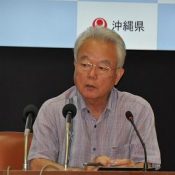
July 5, 2018 Ryukyu Shimpo
On July 5, the Okinawa Prefectural Government announced that tourism revenue in FY2017 rose to 697.9 billion yen, an increase of 5.7 percent or 37.6 billion yen compared with FY2016.
This increase marked a record high for the fifth consecutive year. The number of tourists who came to Okinawa rose by 810,700 (a 9.2 percent increase) from the previous year to 9,579,900 people, which resulted in a great increase in tourism revenues.
Meanwhile, per capita expenditure by tourists in the prefecture decreased by 2,444 yen (a 3.2 percent decrease) to 72,853 yen compared with FY2016.
(English translation by T&CT and Megumi Chibana)
Go to Japanese

July 6, 2018 Ryukyu Shimpo online edition
On July 6 as part of construction in Henoko, Nago City of a replacement facility for Futenma Air Station, work began on installing covering blocks at the K4 seawall on the shore of Camp Schwab.
Mobile cranes were observed lifting these covering blocks into place to form a protective layer. Since Typhoon No. 8 is expected to come upon Okinawa’s shore early next week, the work is probably a preventative measure against the approaching typhoon.

On July 6 on the shore of Camp Schwab in Henoko, Nago, coast guard personnel perform their duties by the silt curtain that washed up on the K4 seawall.
Citizens in three protest boats checked on the status of damage from the last typhoon.
In Typhoon No. 7, a silt curtain in the vicinity of the K4 seawall was washed up onto the seawall. Protesting citizens called to the Coast Guard personnel and construction personnel: “Nature is mighty. Stop destroying the ocean that nature has cultivated.”
Sea turtles were spotted swimming between the protest boats and the Japan Coast Guard boats.
The citizens insisted, “Let’s be careful of the sea turtles.”
Both the protest boats and Coast Guard boats stayed at a standstill as the turtles swam past.
These citizens stated that if nature is destroyed, the sea turtles cannot return to the shore.
Their egg-laying grounds will have been snatched away.

On July 6 on the shore of Camp Schwab in Henoko, Nago, cranes lift covering blocks into place on the K4 seawall.
(English translation by T&CT and Erin Jones)
Go to Japanese
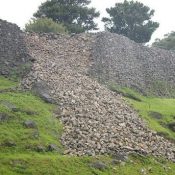
July 4, 2018 Ryukyu Shimpo
Due to the wind and rain from Typhoon Number Seven that passed through the main island of Okinawa between late in the evening on July 1 and the morning on July 2, part of the castle wall of World Heritage site Nakijin Castle collapsed.
Specifically, the eastern side wall of the main enclosure of the castle that was built between the mid to late 14th century collapsed. An area about 9.7 meters wide by 6.4 meters tall collapsed.
After the typhoon passed through, members of the village’s board of education that manages the Nakijin Castle inspected the grounds and made the discovery.
To avoid secondary damage involving tourists, the board segregated the area with rope to prevent people from entering.
In 2001, a part of the castle wall was also damaged as a result of a typhoon.
The board plans to submit a damage report to the national and prefectural government.
They will also coordinate with the Okinawa’s Cultural Properties Division and Agency for Cultural Affairs regarding maintenance and restoration.
The village’s Cultural Properties Section Head Yasushi Tamagusuku said, “It’s not a place we can bring in heavy machinery, so it’s going to take considerable amount of time to restore it.We are at our wits’ end.”
The Nakijin Castle, along with the Zakimi, Katsuren, Nakagusuku, and Shuri Castles ruins were registered as a World Heritage site collectively as the Gusuku Sites and Related Properties of the Kingdom of Ryukyu in 2000.
In the 2010 Ryukyu Islands Earthquake that recorded a lower-five seismic intensity on the seven-point Japanese scale, part of the Katsuren Castle wall collapsed as well.
(English translation by T&CT and Chelsea Ashimine)
Go to Japanese
July 3, 2018 Ryukyu Shimpo
It recently came to light that the Ministry of Defense (MOD) is considering locations in Okinawa for depots to store ammunition and other resources for Japan’s Ground Self-Defense Forces (JGSDF). Establishing such a depot at JGSDF Vice-Camp Katsuren in Uruma City is a plan that the MOD is highly considering.
Also, the MOD wants to simultaneously introduce transport ships to carry Self-Defense Forces (SDF) personnel and materials between the Nansei Islands. The MOD is further advancing its move toward functional enhancement of SDF bases in Okinawa under the pretense of providing the Nansei Islands with defense capabilities.
In March this year, the Amphibious Rapid Deployment Brigade was established under the JGSDF at Camp Ainoura in Nagasaki Prefecture with the responsibility of performing island recapture operations. Due to ongoing construction such as that of JGSDF camps on Miyako Island and Ishigaki Island, the need for more depots is also rising. Before this point, the lack of depots in Okinawa, and potential advancements to inter-island transport, were not been pointed out as matters to which to attend.
Currently, the JGSDF has depots in Hokkaido, Tohoku, Kanto, Kansai, and Kyushu equipped with resources such as ammunition and fuel for training and emergencies as well as logistical support. Subdepots and branches can be established under depots. So, substructures may be established under depots in Okinawa or under Kyushu Logistics Depot on JGSDF Camp Metabaru in Saga Prefecture.
Vice-Camp Katsuren is near White Beach, which is used jointly by the SDF and U.S. military. Katsuren is equipped with a depot and for Marine transport.
However, because the SDF is currently using private ferries to transport personnel and materials, some have strongly encouraged the SDF to use its own form of transportation. Now the SDF is exploring options for a plan to bring in its own form of transport.
The MOD aims to have the plans it is considering reflected in its National Defense Program Guidelines and Mid-Term Defense Program, which will both be formulated by the end of this year.
(English translation by T&CT and Erin Jones)
Go to Japanese
June 21, 2018 Ryukyu Shimpo
The Okinawa Prefectural Government (OPG) has received notification from the Okinawa Defense Bureau (ODB) that depositing soil into the ocean will commence on August 17 as part of the construction of a replacement facility for Futenma Air Station in Henoko, Nago City. On June 20 at a meeting in Naha City, the All-Okinawa Coalition Against Construction of the New Base in Henoko decided to hold a prefectural citizens’ rally on August 11 toward blocking soil deposits.
Over 30,000 people are planning to attend. The rally will be held on Onoyama Park’s athletic field in Naha City at 11:00 a.m. on August 11. Governor Takeshi Onaga will be invited to attend.
The Coalition also decided to hold a prefectural gathering in front of the gate to Camp Schwab in Henoko, Nago on July 7 at noon.
Those gathered will be requesting that dugongs and coral be protected, that soil depositing not be allowed, and that the construction of the new base be abandoned.
Over 2,000 people plan to attend this gathering.
At a post-meeting press conference, Director Takashi Yamamoto of the All-Okinawa Coalition said, “The fight against the new base in Henoko is coming to a head.” He also expressed his desire to hold successive actions and rallies to bring Okinawans’ popular sentiment to the forefront again and again, and to initiate a course of events that will block construction of the base. Representative Tetsumi Takara of the Coalition said, “I want to reiterate that we will not give up.”
(English translation by T&CT and Erin Jones)
Go to Japanese

July 1 2018 Ryukyu Shimpo
The Okinawa Convention & Visitors Bureau (OCVB), which promotes an initiative that invites students from abroad for educational travel, reported on June 30 that the number of students who came to Okinawa in 2017, as far as the OCVB know, grew to 44 groups totaling 1,565 students.
Many groups were interested in experiencing the cleaning time and school lunches that students in Japan do themselves, which is rare in other countries.
The OCVB is anticipating the numbers to continue increasing in 2018 with an expected 65 groups totaling 2,500 students.
The same initiative welcomed 638 international students from 25 groups in 2016.
The figures for 2017 are about 2.5 times that of the previous year.
Examples of activities include learning about the oceans and mountains in Okinawa, experiencing Okinawan culture through activities like Eisa dancing, and other activities such as taking care of small animals.
Kazuko Iha, the principal of Hisabe Elementary School in Nago who has been very active in taking in international visitors says, “I want to teach the students to interact with people from different countries from a young age, so that they can succeed globally in the future.The OCVB has been promoting the exchange program by pitching school tours and educational travel to foreign schools. OCVB executive director Morikazu Yugawa said, “It is also good for the children of Okinawa, and is a good learning experience.”
(English translation by T&CT and Sam Grieb)
Go to Japanese
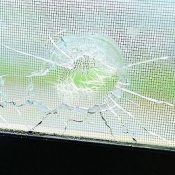
June 28, 2018 Ryukyu Shimpo Digital Edition
Okinawa Prefectural Police announced on June 28 that a crime lab had confirmed that the two windows of a farm shed in an orchard in Sukuta, Nago, which were broken on June 21 by, “what appeared to be a fired bullet,” were in fact caused by a discharged firearm.
A single bullet had been fired, although the owner of the bullet remains unclear. Okinawa Police say that it had likely been fired by one of the heavy firearms in use at the nearby U.S.-run Camp Schwab, and they have inquired with the camp’s military police. The U.S. military has still not indicated whether or not the bullet was theirs, but as a precautionary measure has kept Camp Schwab’s firing range 10 closed since June 22.
This is certainly not the first time there has been an incident involving a stray bullet from Camp Schwab in the Sukuta neighborhood, so the likelihood that this stray round came from the U.S. military is high.
The Okinawa Police were able to confirm that based on the scarring on the bullet, which can act as a “fingerprint” linking it to a specific firearm, that the bullet had been fired by a heavy weapon.
They have requested the U.S. military, who use heavy weapons, provide data as well as some bullets of the same type.
In 2002, there was a similar incident involving a bullet fired from an auto-cannon landing in a nearby pineapple grove in Sukuta.
(English translation by T&CT and Sam Grieb)
Go to Japanese
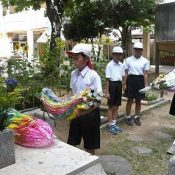
June 29, 2018 Ryukyu Shimpo Digital Edition
On June 29, a memorial service for the 1959 Okinawa F-100 crash was hosted at the Miyamori Elementary School by the student council.
It has been 59 years since a jet fighter plane crash landed due to poor maintenance in the residential areas and Miyamori Elementary School in Ishikawa, Uruma City.
About 550 students attended the memorial service.
The student representative placed flowers and 1000 paper cranes by the Nakayoshi Jizo (Friendly Stone Statue), a monument carved with the names of the 18 people that lost their lives in the accident.
Student council member Yochina Ikemiya, 11, said, “We cannot let a tragic accident like this happen ever again. I would like to pass down the story of the accident to younger generations and to those who don’t know about it.”
(English translation by T&CT and Chelsea Ashimine)
Go to Japanese

June 26, 2018 Ryukyu Shimpo
The peace poem by Rinko Sagara, a 14-year-old student in her third year at Minatogawa Junior High School in Urasoe City, has received a lot of attention on the internet.
She read her poem at the “Irei no hi” Memorial Ceremony to Commemorate the Fallen on the Anniversary of the Battle of Okinawa in Itoman City on June 23.
Many politicians, artists, and other celebrities praised the contents and recitation of the poem on Twitter.
The title of the peace poem is “Live.” In addition to the content of the poem, which pledges no war and includes Sagara’s determination to build future peace, her powerful recitation of seven and half minutes at the memorial service was received with warm applause.
Music critic Reiko Yukawa said, “It was a wonderful declaration of resolution, a splendid original poem with powerful words.”
About Sagara’s recitation, Yukawa commented, “Rather than just reading the characters, [her speech] overflowed with radiant insights… Please watch over this person for 20 years. I hope Japan will be a place where this person shines.”
Vocalist Masafumi Goto (Gotch) of a popular rock band, Asian Kung-Fu Generation, said, “Very nice. I feel a love of one’s country in this kind of poetry.It is a love for one’s homeland and something we should hand down to future generations.”
He continued, “I get goosebumps every time I watch it. Her facial expression changes with the sentences. There is no attachment to the distance between words, body, and emotion.”
He praised Sagara’s poem and posted on the internet about her recitation more than four times.
Rakugo performer Danshiro Tatekawa said, “I am impressed. This heart thinks about the war of 73 years ago, commemorates the war dead, expresses the beauty of Okinawa, and longs for peace. This is real patriotism. The way she read without putting on inflections was also good. Her composition reaches the audience directly.”
Daisuke Muramoto of comic duo Woman Rush Hour showed the video clip and wrote, “I want all news programs to cover this. It is amazing.”
Historian Akifumi Sumitomo said, “It is a great poem that must be preserved for a long time as a historical record of contemporary history.”
(English translation by T&CT and Megumi Chibana)
Go to Japanese
June 13, 2018 Ryukyu Shimpo
An event to commemorate former governor of Okinawa and emeritus professor at the University of the Ryukyus, Masahide Ota, who passed away in June, 2017, was held in Naha the evening of June 12.
He died at the age of ninety-two.
The ceremony was held at the Prefectural Center for Equality Tiruru on the anniversary of his death.
Approximately 270 people, including people from his home island Kume, his former students, and former government officers, attended the ceremony to reflect on his life and personality.
The committee, which included Mitsuko Tomon, Mikio Higa, and Tokushin Yamauchi, held the event.
The participants showed the former governor’s wide-reaching network of relationships, even Keiichi Inamine, who ran against Ota in the gubernatorial election, attended the ceremony.
Mitsuko Tomon, a former student of Ota’s who served as vice-governor under Ota, commented “He took a lead role in promoting women’s participation in politics before other prefectures in the country. I was fortunate to have met such a wonderful governor.”
Mikio Higa, 87, who has been connected with Ota since 1949, also missed his old friend, saying “He held non-violence and peace as the center of his philosophy. I think he wished to reveal and carry over the reality of the battle of Okinawa to future generations.”
A video of Ota was also played during the ceremony.
With the songs “Jana-bushi” and “Tinsagunu-hana” played as a musical tribute, participants shared their memories of Ota.
(English translation by T&CT and Sayaka Sakuma)
Go to Japanese










 Webcam(Kokusai Street)
Webcam(Kokusai Street)


